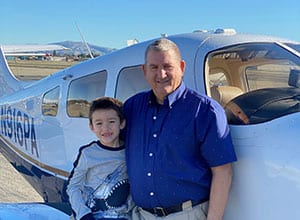Dave Bonnell - Flight Instructor
Bay Area Flying Club
| Flight Instructor: |
CFI |
| Certificates Held: |
Commercial Single Engine Land, Instrument Rated |
| Education: |
Las Positas College, A.S. Criminal Justice |
I was inspired by aviation while growing up around naval aircraft at the Alameda Naval Air Station and Moffett field. In 1985 I had my first opportunity to fly in a Beechcraft Skipper and have had the flying bug ever since. The following year I obtained my PPL and joined the U.S. Navy for the next 7 years.
In 2000, I joined the Alameda County Sheriff’s Office, where I was allowed the opportunity to fly in their Cessna 207, and knew I wanted to expand my knowledge in aviation. During this time, I taught at our Academy and found my additional passion in teaching. That was when I decided the best way to fulfill both aspirations was to become a Flight Instructor. In 2015, I began working on my Instrument rating, followed by my Commercial and Multi-Engine. In 2019, I obtained my Flight Instructor rating.
I am looking forward to bringing my experience and knowledge of flying for others wanting to fulfill the same passion for flying that I have had for years. I am excited about providing a fun and safe flying experience here in Livermore for all my students, while continuing to expand my aviation experience. I am excited to teach you, so give me a call and let’s get your aviation career off the ground!
5 useful questions to ask an instructor:
Why did you become a flight instructor?
Regardless of the answer, the way an instructor talks about why they fly is what is important. Look for
someone that is excited by teaching. They should have a genuine interest in giving others the gift of flight.
How long have you been flight instructing?
Some Instructors have thousands of hours under their belts and have been flight instructing for their entire
careers. Others have a few hundred and are just beginning. A seasoned instructor will have a lot of experience
but may have a set teaching style. A freshly minted instructor has less aircraft time but is able to relate to
common learning obstacles, having undergone their own flight training in the not too distant past. There are
advantages to both types of instructor.
How do you keep track of your student’s progress?
Using a syllabus is essential so that both student and instructor can track progress and milestones so make
sure your instructor uses one. Talk to other students and ask them what kind of reading their doing, what
books they’re using and the type of homework they’re getting. There should ALWAYS have some type of “homework”
assignment at the end of each lesson.
What is your availability?
Some instructors are part-time and work separate jobs during the week. Others are full-time, but may want to
have personal and family time on the weekends. Find an instructor with compatible availability. Flying at least
twice a week is the best way to progress quickly through accomplishments with less effort and less overall costs.
Choosing an instructor that is able to fly on the same schedule helps to keep flight training on a consistent path.
I’ve heard people talk about “stalling an airplane.” Can you tell me what it means?
This is a classic question. Regardless of knowing what an “aircraft stall” is or not, how an instructor explains
this concept will give great insight into how they can explain concepts. Are they patient? Do they use simple
terminology that is easy to understand? Do they ask questions to make sure their student understands, or do they
over simplify to brush off the question? Find an instructor whose instructing style is a good match.

